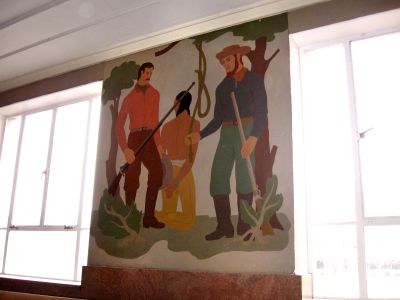Tribes, state agree on how murals should be explained

BOISE – Murals depicting white settlers accosting and then hanging a shirtless Native American man have been displayed openly in Idaho’s temporary Statehouse for the past year, with a note from the state Historical Society promising that interpretation of the murals is “forthcoming.”
Now, after a year and a half of negotiation, the state and Idaho’s five Indian tribes have agreed on wording for interpretive plaques, which tell of the bloody clashes between the cultures that occurred as white settlers took over the Boise Valley a century ago. The plaques will go up before this year’s legislative session.
“It was a long process,” said state historian Keith Petersen. “It was time-consuming to work on, but I think it was time well-spent to get the words down to where everyone could agree to them.”
Said state Sen. Mike Jorgenson, R-Hayden Lake, who serves as chairman of the Idaho Indian Affairs Council, “It’s been a long haul, but we’ve finally got them. Both the tribes and the Historical Society worked on that and we’ve finally reached agreement.”
The Idaho Indian Affairs Council includes representatives of Idaho’s five sovereign Indian tribes, state legislators, and representatives of the governor’s office.
Petersen said it was the tribes’ suggestions that first prompted the unveiling of the controversial murals, part of an extensive series that adorns the walls of the old Ada County Courthouse that dates back to the Works Progress Administration of the 1930s. The government paid out-of-work artists during the Great Depression to create art for public buildings like the courthouse, and the Boise murals are Idaho’s largest remaining collection of such art – though not the most admired.
“From the beginning, they were controversial,” Petersen said. “That happened from Day 1.”
Early objections were more to the crudeness of the colorful artwork – one woman is depicted with two right arms, for example – than the subject matter of the two showing the hanging. But a district judge in the courthouse – Judge Gerald Schroeder, who later served as chief justice of Idaho’s Supreme Court – was so offended by the lynching murals that he ordered them covered over with large Idaho and U.S. flags, which hid the murals for years.
Then, after Ada County built a new courthouse, the art deco building became the temporary home of the state Legislature, which is meeting there while the state Capitol across the street is being renovated. Lawmakers debated whether to hide, remove or keep the controversial lynching murals, which don’t depict a specific historical event.
“It was really the Legislature bringing the tribes in to look at them that convinced everyone there was an educational opportunity,” Petersen said.
The new interpretive plaques tell the story behind such depictions – a shocking and brutal story of how the tribes that once occupied the Boise Valley were driven out, and in many cases, massacred.
“I don’t think any of the murals in that building depict actual Idaho events,” Petersen said. “But to say there were no hangings of Indians in the Boise Valley is not true – there were Indians hanged right out in Middleton.”
The two new interpretive plaques are headed “The Murals and Native Peoples” and “A Clash of Cultures.”
The first begins, “The two murals on this wall depicting the hanging of an Indian man have been the subject of controversy for years. … Whether the murals depict an actual event is not known. But the scenes are consistent with the clash of cultures experienced in the Boise Valley, and the artwork tells us much about the times when artists created the images.”
The Shoshone, Bannock and Paiute peoples lived in the Boise Valley for thousands of years, the plaque recounts. “They thrived in this region of rich fisheries, abundant game, and good grass.” While tribal members continue to visit sacred sites in and around Boise, little visible trace of their culture remains in the valley, according to the plaque. “Their removal in the 1860s came after years of Indian people defending their valley against white incursion. Seen from this perspective, these murals symbolize how an ascendant culture forcefully removed the original inhabitants.”
The second plaque tells of violent confrontations between white settlers, U.S. troops and Indians, including one of the bloodiest slaughters of Indians in a single encounter in the American West in southeastern Idaho in the 1850s. “Today, the proud heritage of the Shoshone, Bannock and Paiute people still thrives at the Fort Hall and Duck Valley Indian Reservations,” the plaque says. “Their story is an important part of the mosaic of Idaho’s past, present – and future.”